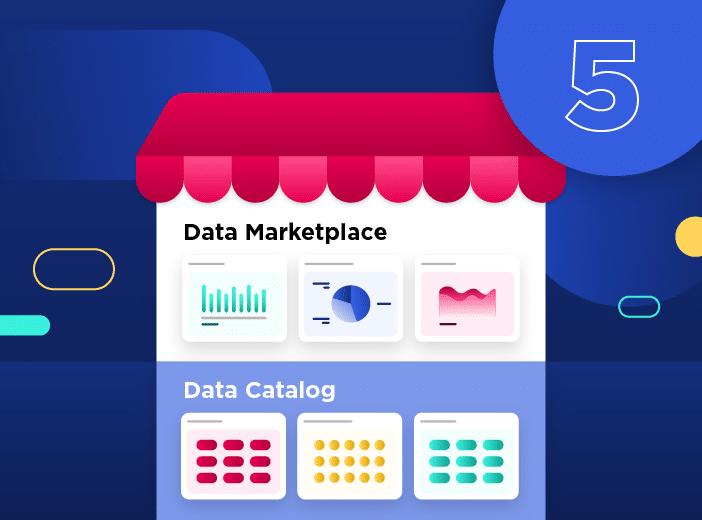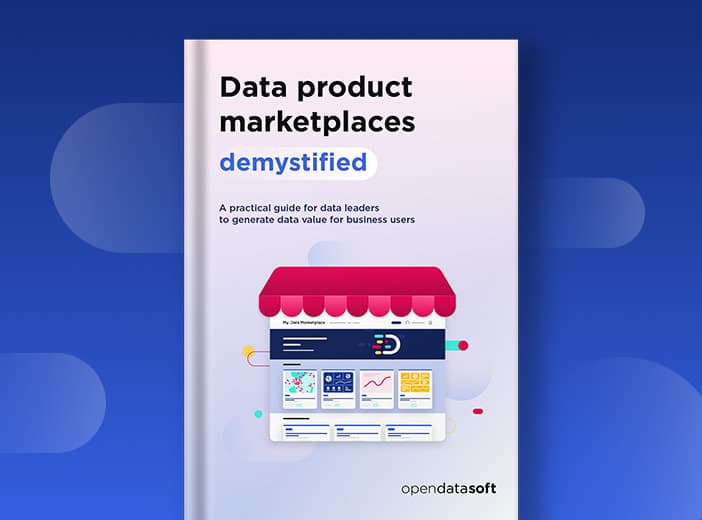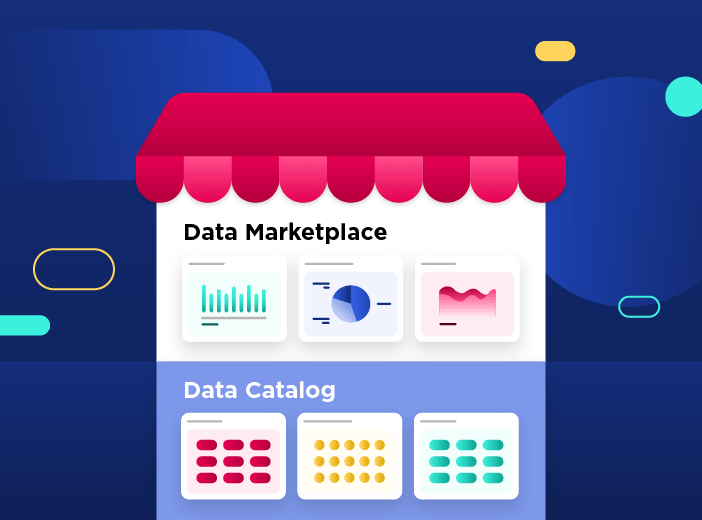5 reasons to enrich your data catalog with a data product marketplace
Creating a data catalog is the first step in your data strategy, enabling you to identify, structure, and take stock of your data assets. This process can be long, technical, and because of the growth of data, potentially ambitious in scope. However, once data is cataloged the question remains: how do you ensure that it is actually consumed at scale?

The results of our latest Data Democratization Study, shows this requirement. 67% of organizations plan to set up a data marketplace to facilitate data sharing and access for business teams. This is a logical next step – without a seamless user experience, or centralized access and context, it is difficult for non-technical audiences to successfully harness and consume data.
This is where the data product marketplace comes in. Designed to drive data consumption and reuse, and inspired by e-commerce, it transforms data into an accessible, visible, and understandable product. It complements the data catalog without replacing it, maximizing its potential.
In this article, we explore five reasons to add a data marketplace to an existing data catalog. Five key ways to broaden adoption, maximize ROI and make data a real driver for efficiency, productivity, and innovation across the business.
1. Attract new users with an e-commerce-inspired experience
Essentially a data catalog is a complete inventory of data. It lists all the data assets in an organization based on their metadata. Data catalogs are designed for technical users such as data stewards, data engineers, and database administrators, providing them with essential technical details (such as origin, quality, flow, owner, and access policies) to ensure effective governance. However, for business users, data catalog interfaces are overly technical and complex, and the tool doesn’t provide direct access to the data itself. As a result, the objective of democratizing access to data remains unfulfilled.
A data marketplace, on the other hand, allows non-technical users to easily explore data and as part of this emphasizes the user experience (UX), through:
- An intuitive UX and simplified journey: navigation within the data marketplace is inspired by e-commerce, with semantic search engines, category tabs, and comprehensive “product” data sheets that provide a clear description of what the data covers, examples of its use, a visual overview, and recommendations of similar data.
- Data packaging: instead of simple technical listings, data is enriched with tangible elements: sample data, graphs/visualizations, one-click calls to action that allow the dataset to be consumed and access request buttons to restricted datasets.
- Accessibility for all: the marketplace is designed so that a product manager, a marketing manager, a buyer, or someone in finance can easily find relevant data, understand it, and consume it without requiring support from a data expert or IT team.
The parallel with e-commerce illustrates how important it is to effectively publicize data. When it comes to the online world, no consumer would buy a product that didn’t have good quality photos, a clear description of its characteristics, and user reviews and recommendations, coupled with easily identifiable buy now buttons. The same is true for data: the marketplace provides a means to trigger conversion, i.e., actual consumption. Thanks to the data marketplace’s interface, employees in the business are able to quickly discover and access resources that they didn’t know existed, considerably expanding usage of this data and unlocking its value for the organization.
2. Increase data catalog ROI through better discoverability
Setting up a data catalog is often a complex and lengthy task requiring data teams to identify sources of information, structure metadata, set governance rules, and align with IT teams. This technical effort is essential, but it is not enough if it does not lead to data consumption at scale. This is where the data marketplace acts as a catalyst: it transforms an inventoried asset into a consumed asset.
An essential building block
At a time when organizations are looking to rationalize the number of IT tools and solutions they use, they may be reluctant to add a new one. However, a data marketplace is not an additional layer. It is an interface that delivers value and is designed to drive business use of existing data infrastructure.
- It connects to the data catalog and reuses already defined metadata, without duplicating documentation. It can even contribute to metadata enrichment, as we will see later in the article.
- It does not duplicate the data inventory within the catalog, but makes it visible, accessible, and understandable.
The marketplace does not create any new access points into the data architecture, which limits security risks. By integrating data via APIs or native connectors, it avoids incoming flows: no calls are made to source databases.
Strengthening discoverability
Identifying data assets is not enough. They still need to be found — and understood. This is where the data marketplace multiplies the catalog’s impact.
- The search engine takes into account typos, synonyms, business expressions, and multilingual queries.
- Data assets are categorized, staged, and recommended automatically.
- Each data product is readable, enriched, and accompanied by visual elements or examples of reuse.
But the strength of the data marketplace goes much further, providing:
- Meaningful titles to guide business users without jargon.
- Images, icons, thumbnails, or logos to identify data producers or the topics covered at a glance.
- Dynamic filters, which can be applied by fields such as scope, date, data type or usage.
- Built-in visualizations, including interactive maps and automatically generated graphs.
- A familiar graphical experience, adapted to the organization’s brand guidelines and design values.
- Translations in order to deploy a multilingual portal.
In a traditional data catalog, even a well-structured one, a non-technical user can miss out on discovering a useful data asset as they don’t search using exact keywords or the data is not presented in an appealing way. With a data product marketplace, data becomes visible, understandable, and actionable.
Every employee can finally find what they are looking for, immediately understand the structure of a dataset, and act faster, without requiring support. Information becomes available when it’s needed, scaling data consumption.
Delivering the last mile of data infrastructure
The data product marketplace is often referred to as the last mile element of a data strategy and stack. It is not just another tool, but the link between structured data and creating value from it.
This finally delivers ROI on data catalog projects. In our study, 70% of the respondents say they have identified a clear ROI from data sharing. Why? Because data becomes immediately actionable by business teams through the data marketplace:
- A sales person can track sales in real-time without waiting for reports to be provided.
- An HR manager is able to identify weak signals of disengagement before they impact the workforce.
- A CFO can simulate different scenarios with a few clicks instead of waiting for data to be provided.
- A logistics manager is able to optimize deliveries by cross-referencing stock, traffic, and demand.
- A product manager can adjust product features by seeing how it is being used, without waiting to complete in-depth studies.
These are all concrete examples where data is actually used within business operations, demonstrating that the last mile of the data journey is critical to transforming data into impact.
3. Increase use of data assets through intuitive, engaging features
Collecting data is not enough – it must be activated to deliver value. A data product marketplace transforms a passive data catalog into a real space for exploration, where every employee can access, test, and compare information, without requiring technical skills.
The marketplace offers a range of features to support this, including the generation of automatic visualizations by AI, one-click data exports (in common formats such as CSV, JSON, Excel, and Parquet), bookmarking, and similar data asset suggestions. Its intuitive and customizable interface makes it easy to get started, even for non-technical users.
However, above all, the marketplace stimulates collaboration. It allows users to comment, evaluate, share use cases, or collectively enrich data assets. It encourages the spread of good practices between teams, departments, or territories. It breaks down silos, putting an end to static reports, isolated data access, and knowledge siloed in local systems.
As a result, data ceases to be a dead weight. It circulates around the organization and reinvents itself by being used and combined. Essentially, it becomes an operational benefit for everyone, every day.
4. Measure usage with an e-commerce-inspired conversion funnel
In e-commerce, every click counts. Why should it be different for data? A data product marketplace applies digital marketing best practice to internal data consumption, meaning every interaction becomes measurable and every asset can be optimized.
The marketplace tracks everything: product page views, access requests, exports, integrations in dashboards or via API, comments, and ratings. For example, if a dataset generates a lot of accesses but no use, it could be because it deserves stronger promotion, a more engaging product sheet or additional context.
Monitoring can be refined by user profile, such as type of employee, department, or role, making it possible to identify areas of strong (or low) adoption. These insights directly feed into marketplace management strategy, training and communication programs, and the focusing what type of new data assets should be added.
Monitoring enables continuous adjustments, such as highlighting strategic assets, visual enrichment of data, adding use cases or tutorials, or creating personalized paths. Data becomes a controlled product, with its own ways of being accessed and used.
That’s the difference between a static data source and an asset – what can’t be measured doesn’t get improved. Thanks to the marketplace, data teams finally have the tools to measure and improve adoption. And they can boost usage, align data publication efforts with real needs, and adjust their data strategy based on information rather than guesswork.
5. Better metadata information
Data catalog projects often fail due to issues at their core, through problems with metadata quality. For example, metadata can be too incomplete, too technical, or too static. Due to this, data teams struggle to meet the expectations of business users. The data product marketplace reverses this issue by giving meaning and context to documentation.
Making metadata useful — and used
In a marketplace, each data sheet is designed as a showcase. It does not present a raw inventory, but a ready-to-use product, accompanied by a clear context, concrete examples, and integrated business definitions. As a result, data producers no longer write for machines, but for users, and this releases the full meaning and usage of metadata.
Metadata is used to explain the key components of data, illustrate possible uses, and specify the parameters covered. And because data teams see that these efforts really trigger use, in terms of views, exports, and shares, their motivation to improve metadata increases. They no longer document metadata because it is necessary, but because it increases the success of their work.
A compelling editorial experience
Understandable and engaging data sheets make the difference between data being used or not. In a marketplace, data sheets for assets can be laid out, illustrated, and combined with visualizations or explanatory text. Teams have access to customizable templates to structure information, guide reading, and simplify adoption.
Through clear titles, well-chosen visuals, business tone and language this editorial layer makes data more readable, engaging and ultimately more consumable.
Conclusion: the data marketplace, an essential accelerator of consumption
The data catalog remains an essential foundation in an organization’s data strategy. It structures, traces, and secures information. However, it is primarily aimed at technical experts. To get the business on board, break down barriers, and generate use, organizations need to go further. This is precisely what a data product marketplace delivers, transforming data into an actionable product. It makes access more seamless and encourages data usage, creating bridges between teams. And it measures actual impact, rather than simply counting downloads like other tools.
By strategically complementing the data catalog, data marketplaces:
- Extend the use of the catalog to the entire organization
- Accelerate return on investment
- Create a living and shared data culture
At a time when 70% of business executives identify a clear ROI in data sharing, data marketplaces are a vital method of turning data into value.
At Opendatasoft, we help organizations with the last mile of their data strategy, shifting from simply collecting and inventorying data to driving consumption, and value, at scale.



